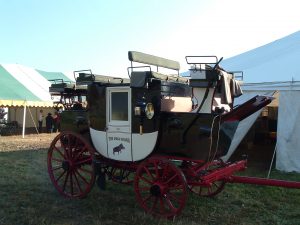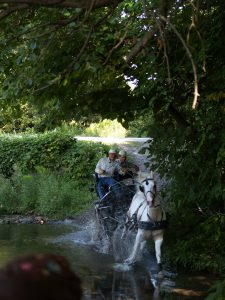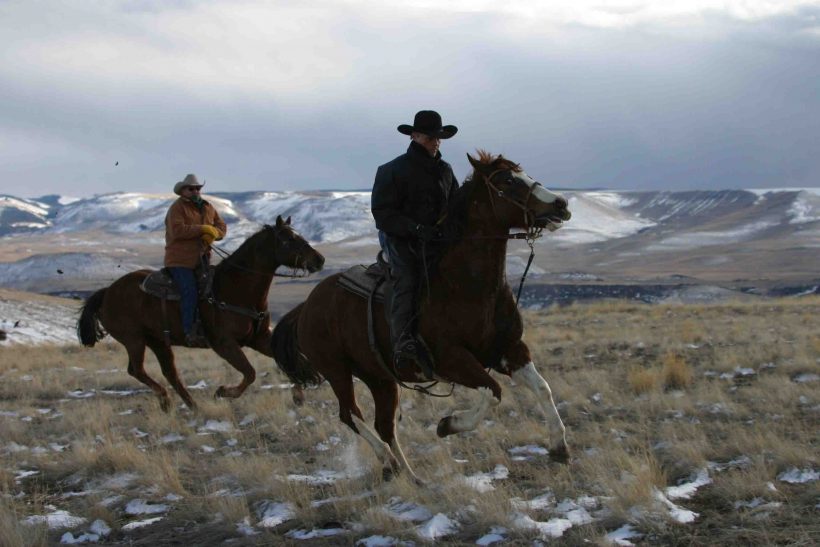RANDY BIRD – Equine Educator 2011
Randy Bird can’t remember a time when he wasn’t passionate about horses. He entered his first pony race at the Roseneath Fair when he was 10. He was barrel racing at 13 in the Western Games and a bull rider for 5 years on the Ontario rodeo circuit. By age 17 he had his sulky licence and was training standardbreds. To many Randy had an obvious calming effect on horses. In 1986 he met Australian horseman Alan Barker who used to oversee the transportation of very expensive horses to Australia and New Zealand. Barker introduced Bird to the training methods of the legendary J.D. Wilton.
“I thought I was good but after seeing a demonstration video of Wilton’s technique featuring Ian Dunn I realized that I knew nothing of horses,” said Bird. And he determined that he would not be satisfied until he had learned Wilton’s technique.
In 1987 Barker invited Bird to accompany him to Australia. They loaded 92 horses on a 747 at Pearson International Airport. Bird called it a flying arc. The plane had set out from Britain with a load of cattle, dogs, rabbits and zoo stock including a Congo Buffalo. There were 17 handlers and flight crew. The plane had been converted to accommodate rows of stalls and the temperature was kept at 55 degrees F for the horses’ comfort. Randy’s task was to help water and feed the horses. When asked about the aroma Bird replied; “It wasn’t stinky – amazingly; although they probably smelled us in Sydney.” Such flights aren’t without risk. What happens if an animal kicks a hole in the plane?
Bird spent 3 weeks in Australia and visited with Dunn who would later visit and stay with Bird at his Harwood farm in Ontario for 3-4 months teaching Randy the basics. Since then Randy has ‘Canadianized’ Wilton’s technique to his needs in educating riding and driving horses ever since.
In 1998, while Randy was training some horses from Saskatchewan, Dennis Tipsword, President of the Michigan Horse Drawn Vehicle Association, visited to look at these horses, saw Randy’s technique, and invited him to give a clinic in Michigan featuring problem horses. “They loved it,” said Bird and it made him think perhaps he should offer more clinics.
When Bob Cook of Maryland first saw Randy he said in 35 years he had never seen anyone quite like Randy and invited Bird to offer a clinic and a network developed from there. Now Bird has clients from P.E.I, Nova Scotia, Quebec, Ontario, and 12 U.S. states including California. “It’s rare to find a trainer who works with riding and driving horses,” said Cook. As it happens, Bird has trained world class horses in both the riding and driving worlds which is very rare.
“Bob got me into a new style of driving – the ‘southern influence’,” said Bird. For the record, a coach can cost as much as $160,000 U.S. Add the cost of horses and equipment and it becomes astronomical.
Clients ask Bird to train their riding horses to drive because the finish helps the horse’s attitude, control and responsiveness by making the horse more trusting of the handler and confident in its work. As the population ages, interest in driving is increasing. “Aging horsemen want a fun, safe way to extend their ‘equine years’,” said Bird. “And they can include the family, kids, grands…who can go for carriage rides.”

Following Bird’s first home seminar he met Australian Simon Wincer (The Man from Snowy River, Lonesome Dove…) who was in the area filming a Disney movie. He told Bird that it was nice to watch someone who can communicate so clearly and calmly with an animal and dubbed Bird, “a quiet man with a quiet horse.”
In 2004, Bird was approached by Rob Davidson (formerly of Global TV) and Albert Botha of Primitive Pictures. It was a cold, miserable December day recalls Bird. They wanted to make a documentary about my training methods. During filming Randy was invited to Upperville, Virginia, for a gathering of 31 coaches, each pulled by 4 horses (or 4 hands) and the film crew tagged along. The coaches traveled Virginia backroads and stopped for lunch at one “farm” where some scenes from Gone With The Wind had once been shot. “Quiet Man, Quiet Horse,” was released in February 2005. Although Bird doesn’t specialize in problem horses and has never been comfortable with the horse whisperer nomenclature he has attracted a number, some of which are featured in the documentary. For example there is the race horse that wouldn’t enter the starter gate, or a horse trailer. Bird solved that problem in an hour and the horse went on to win its first two races.
A second documentary is called Saving the Mustang. An American icon, the Mustang has been protected by U.S. legislation forbidding its export. In Wyoming the mustang is hated by cattlemen (grazing competition) and oil men (damaging equipment). Basically, they were going to be sold for pet food. Having dealt with mustangs previously Bird warned the filmmakers that these were wild horses, unlike anything they had ever experienced. “But they just didn’t get it,” said Bird. Mustangs were the most stressful Bird had ever dealt with in the horse business. “I knew what I was getting into.” These were to be the first mustangs ever allowed to leave the US and some were earmarked for Randy. “I developed a whole new program to train them,” said Bird. “They were the most dangerous horses that I ever worked with and I lost many pounds due to stress,” said Bird who never eats sweets and had no extra weight to lose.

Due to filmmaker foresight, the movie was shot in High Definition before HD was even on TV. And so 5 geldings and 3 mares made the trip to Harwood. As a bonus the mares all successfully foaled. Bird conditioned the wild horses – which had never seen a barn or eaten oats – with feed, over time. Bird had to re-enforce his fencing and basically mustang proof his facility. “I would whistle before approaching so they knew I was coming and wouldn’t be alarmed,” he said. Like Pavlov, he taught them to associate the whistle with food and positive reinforcement. Now, six years later, Bird is driving one of the mustangs and the film, by Stornaway Productions, is slated to be shown on Pet TV during the winter of 2011. With the older mustangs Bird has proven that old horses can be trained and useful. On the down side hoped for funding for this project failed to materialize and Bird has kept the mustangs on his own dime. But “they’re family now and the originals are now 19/20 years old.” This was a unique experience. “Noone else has ever done this,” said Bird.

For more information goto: www.randybird.ca/ or call 1.905.342.3053 (home) or 1.905.342.5557 (stable).
Photos – Albert Botha-courtesy Randy Bird
